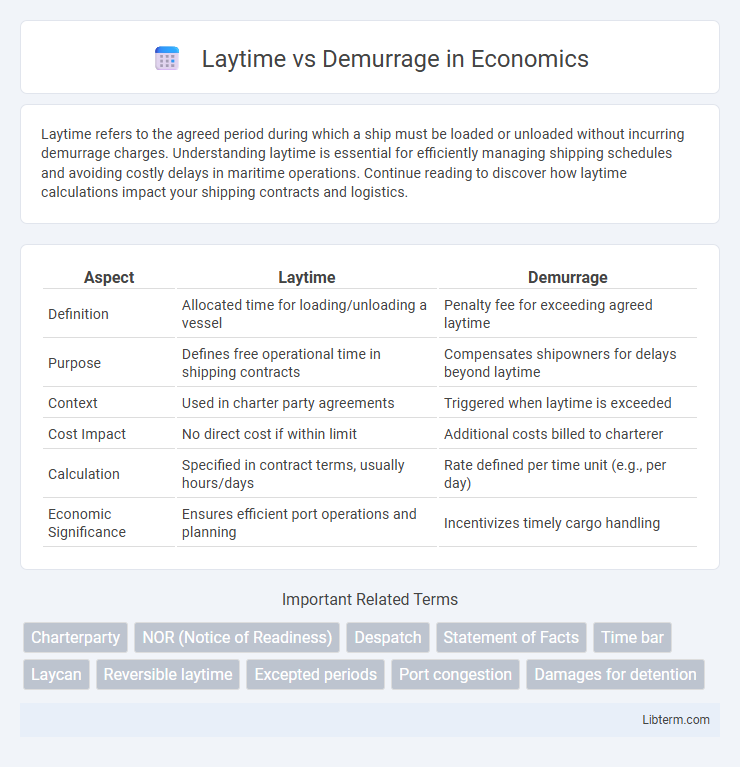Laytime refers to the agreed period during which a ship must be loaded or unloaded without incurring demurrage charges. Understanding laytime is essential for efficiently managing shipping schedules and avoiding costly delays in maritime operations. Continue reading to discover how laytime calculations impact your shipping contracts and logistics.
Table of Comparison
| Aspect | Laytime | Demurrage |
|---|---|---|
| Definition | Allocated time for loading/unloading a vessel | Penalty fee for exceeding agreed laytime |
| Purpose | Defines free operational time in shipping contracts | Compensates shipowners for delays beyond laytime |
| Context | Used in charter party agreements | Triggered when laytime is exceeded |
| Cost Impact | No direct cost if within limit | Additional costs billed to charterer |
| Calculation | Specified in contract terms, usually hours/days | Rate defined per time unit (e.g., per day) |
| Economic Significance | Ensures efficient port operations and planning | Incentivizes timely cargo handling |
Introduction to Laytime and Demurrage
Laytime refers to the agreed period allowed for loading and unloading cargo under a charter party, typically measured in days or hours. Demurrage is the penalty paid when laytime is exceeded, serving as compensation to the vessel owner for delayed operations. Both terms are essential in maritime shipping contracts to ensure efficient cargo handling and risk allocation.
Defining Laytime in Shipping Contracts
Laytime in shipping contracts specifies the agreed period during which the charterer may load or unload cargo without incurring additional charges. It represents the contractual timeframe calculated in days or hours, essential for planning vessel operations and avoiding delays. Accurate definition and measurement of laytime directly impact operational efficiency and cost management in maritime logistics.
Understanding Demurrage: Meaning and Implications
Demurrage refers to the penalty charge imposed on charterers when the agreed laytime for loading or unloading cargo is exceeded. It serves as compensation to the shipowner for the additional time the vessel remains detained beyond the contractual free time, impacting shipping schedules and costs. Understanding demurrage is crucial for optimizing maritime operations and managing contractual liabilities in charter party agreements.
Key Differences Between Laytime and Demurrage
Laytime refers to the agreed period allowed for loading or unloading cargo, while demurrage is the penalty incurred when this period is exceeded. Laytime calculations are based on contract terms, often measured in hours or days, whereas demurrage charges are financial compensations imposed to cover vessel delays. Understanding their distinction is crucial for efficient shipping operations and cost management.
Calculating Laytime: Methods and Examples
Calculating laytime involves determining the agreed period allowed for loading and unloading cargo, typically specified in the charterparty agreement, using methods like fixed laytime, clausetable, or working days calculation. For example, in fixed laytime, the contract states a set number of hours or days for cargo operations, and any excess time leads to demurrage charges. Accurate laytime computation requires tracking vessel arrival and commencement of cargo operations, applying exceptions such as weather delays or Sundays, ensuring precise demurrage assessment to avoid disputes.
Demurrage Charges: Calculation and Application
Demurrage charges are calculated based on the agreed laytime allowance exceeding the vessel's stay in port beyond the contractual free time, typically expressed as a daily rate per vessel or tonnage. These charges compensate the shipowner for loss of potential earnings due to delays caused by the charterer or other factors beyond the agreed laytime. Demurrage is applied from the moment laytime expires until cargo operations are completed or the vessel departs, ensuring financial accountability for prolonged port stays.
Common Causes of Demurrage in Shipping
Common causes of demurrage in shipping include delays in cargo loading or unloading due to insufficient terminal equipment or labor shortages, customs clearance complications, and unexpected vessel congestion at ports. Weather disruptions, inaccurate cargo documentation, and disputes over cargo specifications also contribute significantly to extended laytime and resulting demurrage charges. Proper planning, efficient communication between shipowners and charterers, and strict adherence to laytime agreements help minimize demurrage risks.
Legal Aspects of Laytime and Demurrage
Laytime and demurrage are critical legal terms in maritime contracts that dictate the permitted loading or unloading time and penalties for delays, respectively. The interpretation of laytime clauses and demurrage charges hinges on contract specifics, such as charter party agreements, which define the commencement, suspension, and calculation methods. Courts often assess whether delays were due to charterers' or owners' fault, interpreting terms like "excepted periods" or "force majeure" to determine liability and enforce demurrage claims under international maritime law.
Preventing Demurrage: Best Practices for Shippers
To prevent demurrage, shippers should optimize laytime management by closely monitoring vessel arrival and cargo handling schedules to avoid delays beyond the agreed laytime. Implementing accurate booking systems and maintaining clear communication between ports, agents, and carriers ensures efficient cargo operations. Utilizing real-time tracking and contingency planning helps mitigate unexpected disruptions, reducing the risk of costly demurrage charges.
Conclusion: Importance of Managing Laytime and Demurrage
Effective management of laytime and demurrage is crucial for minimizing shipping costs and avoiding financial penalties in maritime operations. Accurate calculation and monitoring ensure optimized vessel utilization, reducing idle time at ports and improving overall supply chain efficiency. Implementing robust systems for laytime tracking safeguards against disputes and enhances operational transparency between charterers and shipowners.
Laytime Infographic

 libterm.com
libterm.com